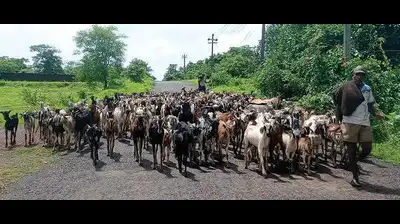ARTICLE AD BOX

Mapusa: Symbiotic relations are usually seen in the wild, but such a connection has been developed by the Dhangars (or goat herders) of Malegaon, Maharashtra, and farmers just across the border in Pernem.
During the monsoon, the herders, with hundreds of goats, enter Pernem to give their goats an escape from the sticky soil back home, which can cause the animal’s feet to rot.This community is known to be traditionally semi-nomadic, migrating with their herds in search of pasture. Their migration is a fascinating glimpse into the life and practices of the Dhangar community. It highlights their traditional pastoralist lifestyle, their deep connection with the land, their animals, and the challenges they face.In Pernem, farmers give the herders and their goats shelter, and the goat droppings serve as organic fertilisers for their fields.As of Aug, there are around three herds from Malegaon sheltered in Torsem, two in Paliem, and two in Parcem, with the single largest herd having over 500 goats.A local in Pernem said that farmers start coming to Goa in May. They have makeshift huts for their families, and separate shelters built for their animals.
“They return to their native place after Diwali when rains have receded, and there is enough fodder for their cattle,” said the local.The communities prefer Pernem because of the close proximity, environmental conditions similar to Malegaon, and the ample availability of fodder.The migration is of several miles, and keeps the herders away from home for about six months every year.The farmers practice the rearing of free ranging goats — the traditional method of letting goats graze on natural vegetation or pastures or harvested fields for both meat and milk production.Goat-herding community member Ganesh Varak, presently based in Torsem, explains a significant environmental challenge they face in their home region. “The ‘chikan mati’, or black sticky soil, becomes wet, and remains sticky for long periods in the rains, which causes the feet of their goats to decay,” he told TOI. “To combat this problem and protect the herd, we migrate to the upper region of Goa (in Pernem), where the land has rocky surfaces.”The people of Pernem provide free land for the Dhangars to stay, as the goat droppings fertilise the land. It is considered among the manures for the coconut crop.The shelters for the animals are made with an elevated wooden floor so the goats can avoid contact with the wet soil during their resting period.Savitri Varak explained the compartmentalisation of herd huts. “There is a need for a separate compartment for the sick goats to prevent the spread of diseases,” she said.



.png)
.png)
.png)
















 1 day ago
7
1 day ago
7







 English (US) ·
English (US) ·